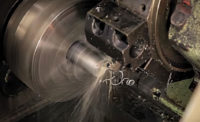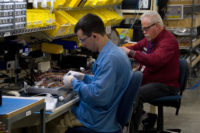Manufacturing high-quality products on a consistent basis is never easy. This is especially true for complex products used in consumer, business and industrial electronics. Manufacturers of these items typically focus on two things to optimize quality: using error-free parts and making sure that electrostatic discharge (ESD) doesn’t damage the parts prior to assembly.
However, there are two main problems related to ESD. The first one is it’s invisible. For example, a discharge of just 100 volts is well below the level that humans can sense, but it can still cause immediate and total part failure.
A secondary problem is ESD can be easily triggered when an assembler comes in contact with a conductive material present on a work bench. Such triggering is a constant concern, unless the assembler uses a bench that is designed to prevent ESD.
Item Industrietechnik GmbH makes a Work Bench System (WBS) that features various ESD-safe components, including table tops, frames and accessories like wristbands. Several years ago, electronics manufacturer Bachmann GmbH & Co. KG replaced its standard welded-steel-tube benches with those made using the WBS.
Bachmann is a medium-sized company that develops, manufactures and distributes electrical engineering components and systems. Their products include work surface connection panels for homes and offices, and socket systems and power strips for trades people and domestic use.
All products are made of high-quality aluminum or robust plastic. The company was founded in Stuttgart, Germany, in 1947, and currently has manufacturing plants and offices in Germany, Romania and China.
Thomas Konietzko, production manager in charge of lean production at Bachmann, says the company’s old steel-tube workstations were designed as “islands” incompatible with other production systems. They also lacked the flexibility necessary for workers to rapidly adapt to changing production requirements.
“Those workstations were no longer able to meet our [production needs],” says Konietzko. “We tried various suppliers’ [products], but were quickly won over by the WBS’ high degree of flexibility. Now, we are [ready] for any [production changes] we may need to make in the future.”
Another reason why Bachmann chose the WBS is because of its compatibility with the item MB Building Kit System. Konietzko says assemblers at Bachmann regularly use the kit’s aluminum profiles to build equipment fixtures.
When designing Bachmann’s new work benches, company engineers worked closely with assemblers to optimize ergonomics. Konietzko says their input resulted in benches that limit physical strain during assembly, while improving safety, efficiency, error rate and productivity.
“Working conditions [here] have significantly improved,” concludes Konietzko. “We have equipped the entire production hall with item work benches, and already ordered more.”
WBS benches are modular, height adjustable for various production processes and come in 80 configurations. More importantly, they emphasize a design approach that item calls ergologistic, where worker ergonomics and company intralogistics complement each other.
The result is a production system that optimizes material flow to workers, often through the use of transport trolleys. An online SystemMobile configurator lets companies design the best work bench for an application with just a few clicks.
For more information, call 844-828-9378 or visit www.item24.com.





